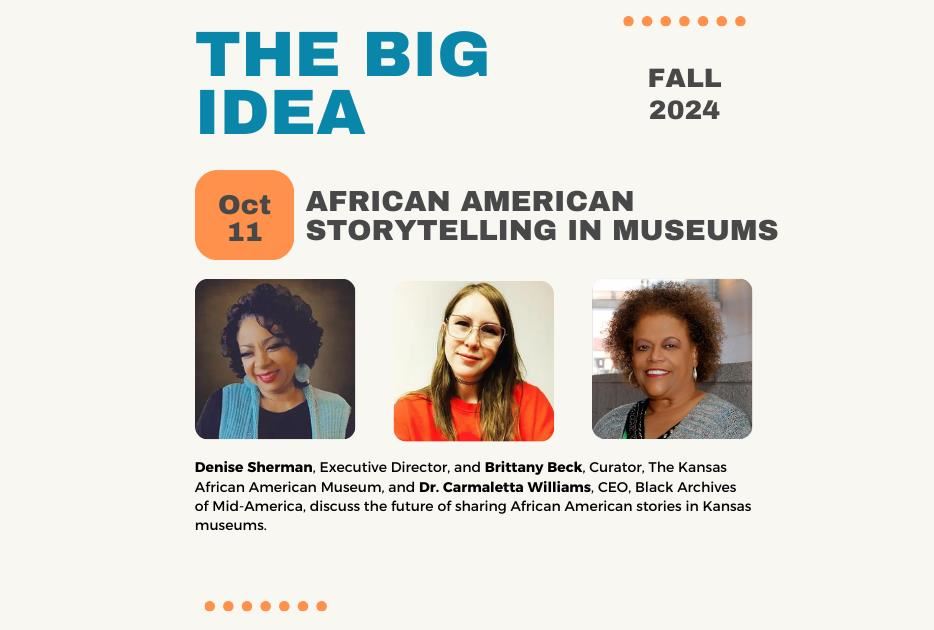

Big Idea: African American Storytelling in Museums
October 7, 2024
In the 1970s, American society was changing. While urban renewal was displacing Black neighborhoods, African Americans were also gaining elected positions in local governments and increasing their political influence. The Black Power Movement advocated pride, self-determination, and leadership of Black institutions. And the Black Archives of Mid-America and The Kansas African American Museum were both created.
In 1973, the First National Black Historical Society was launched in Wichita to help save the Calvary Baptist Church, now home to the museum. The group worked to save the building alongside the stories of African Americans who lived, worked, and worshipped in the racially segregated area. Similarly, the Black Archives of Mid-America was founded in 1974 in Kansas City (MO) to collect and preserve the history of African Americans living in the Midwest.
Fifty years later this work remains as important as ever in expanding our understanding of Kansas history. “Our theme is ‘Tell the story, the stories that have not been told,’” said Denise Sherman, Executive Director of TKAAM.
Sherman shared an example. “John McLendon should be as well known as James Naismith, not only in Kansas but everywhere. He is as important to the development of basketball as Naismith, and he was the first African American head coach. Yet he might get a kernel, a nod, in the story of basketball,” she said. “At TKAAM, it is our job to tell the complete story.”
Dr. Carmaletta Williams, CEO of the Black Archives of Mid-America in Kansas City, is also driven by telling the stories that are not well known, or undertold. “We have activated this place, expanded it, and we’re trying to make it interactive,” she said of the archives. “Sharing our stories is not revisionist history. It is telling the truth.”
Williams and Sherman both make the point that Kansas history is African American history and has been since before settlement. In museums, however, the stories of African Americans are often missing or inaccurate.
“The stories are what the community believes to be true,” said Sherman, speaking of how African American experiences have been portrayed in Kansas museums she’s visited over the years. “We are more interconnected than we often believe.” To illustrate her point, Sherman explained how many Kansans are surprised to learn that more than 25% of cattle trail cowboys were Black because popular images of the American West have erased their contributions. Sherman said that it’s time to correct these past oversights and update the incomplete stories.
“We are not that far apart,” she said. “When people come to TKAAM, their discovery makes a big shift in their thinking.”
Many Kansas museums today are working to expand the African American story in their exhibits, but it takes determination, sensitivity, and respect.
“Learn our stories by including us in the process,” Sherman said. “Do not use African Americans as a resource, to get the information you need and run off. Start first by asking if you have permission to ask questions. Ask if you can learn their stories, and then ask how the stories should be told.”
Many African American community members in towns both big and small are looking for a safe space and encouragement to share, to coach, and to teach about their experiences, Sherman said.
Williams stressed that working with community members is vital to today’s museums. “There is an old saying that the best stories are in the cemetery,” she said. At the Black Archives of Mid-America, they have shifted their approach to finding stories. “We have a strong oral history program. We have two recording studios here to get people’s stories. People are eager to have their stories told.” In other words, museums can begin by collecting the stories of people living today.
Brittany Beck, curator at TKAAM, echoes this perspective. “Your greatest asset is the people in your community,” she said.
Beck explained her recent research on Black Wichita from the 1970s to the present. “I thought I knew that story well, but I have learned that I don’t,” she said. “So I need to interweave the stories I have recently learned in my research and switch how I view the narrative. I have to approach things with a very open heart and view things a different way.” As Beck explained, learning new information about your own community can be challenging and sometimes uncomfortable.
“Open yourself into another space and immerse yourself,” added Sherman. “Even if it is a hard subject. It’s okay to feel whatever feelings you have. It’s okay to tell your stories, too. We often ask as visitors are leaving, ‘What surprised you today?’ It’s amazing what people will share.”
Williams suggests that visitors bring their imaginations and see themselves as participants. “Try to imagine yourself in that period, that story. See the whole community, all of the people who were there. What would it be like to talk to the people around you? What would your culture be? Share their experiences, share their customs, share their languages.”
Spark a Conversation
- VISIT the Kansas African American Museum in Wichita
- VISIT the Black Archives of Mid-America in Kansas City
- INVITE Dr. Carmaletta Williams to your community with her Speakers Bureau presentation "Free Did Not Mean Welcome."
- LISTEN to the Kansas 1972 podcast episode "Uprooted" to hear the story of urban renewals impact on Wichita and the preservation of the Calvary Baptist Church.
- LEARN a more robust history of Black cowboys from the Library of Congress, "Black Cowboys at Home on the Range."



